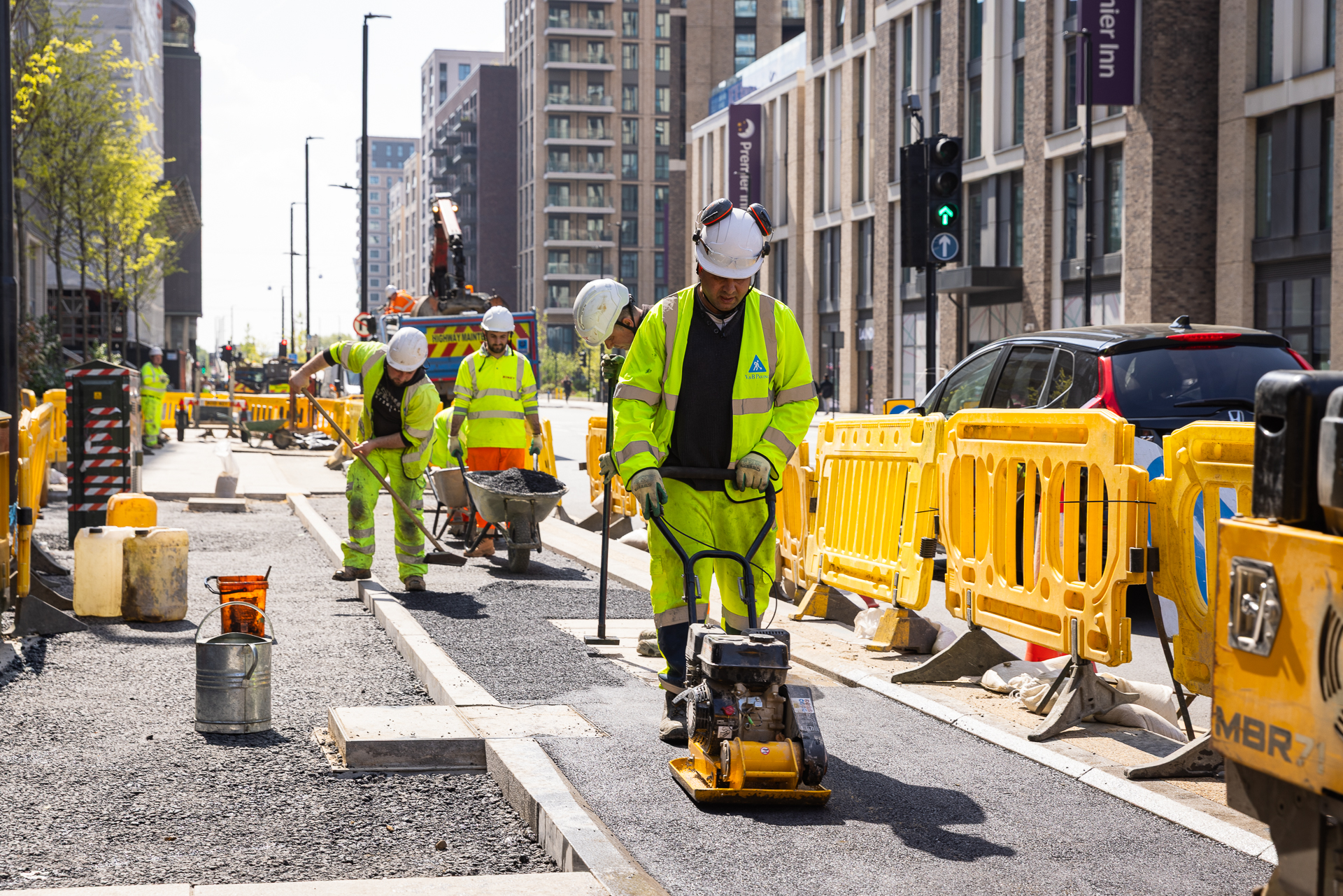Planned maintenance
This page contains a summary of Newham’s highways maintenance activities. The information contained here enables local taxpayers to understand how the council is improving the highways network in the borough, and shows how funding is obtained and spent.
Since 2016, we have embarked on an ambitious journey to transform our highway network through preventative maintenance programmes like Keeping Newham Moving. Our investment averaging £10 million annually since 2016 has delivered significant improvements, including resurfacing over a quarter of our road network and significantly reducing the proportion of our roads in poor condition.
A Newham news article summarising Newham’s highways maintenance activities is available to read here.
A copy of Newham’s full Local Highways Maintenance Transparency Report (May 2025) (PDF) is available to read.

Contractors building a new cycle track upgrading the pavement in Canning Town as part of the Royal Docks Corridor project (May 2025)
Highways maintenance spend
In the 2025-26 financial year, Newham Council is planning to spend £8.85m on capital-funded projects (new infrastructure) and £2.20m on revenue-funded projects (reactive maintenance). In the previous five years (from 2020-21 to 2024-25) the Council spent a total of £43.79m on capital-funded projects (an average of £8.76m per year) and £9.92m on revenue-funded projects (an average of £1.98m per year).
State of the highways network
The state of the highways network refers to the condition of the roads. Overall, there has been an improvement in the state of the Newham highways network in the past few five years.
When presenting road condition data, roads are split into three types of roads: A-roads, B-roads and Unclassified roads. Road condition is split into three levels: Red (should be considered for maintenance), amber (maintenance may be required soon) and green (no further investigation or treatment required).
A-roads went from 8.5% in the red category in 2020 to 10% in the red category in 2023. A-road condition data for 2024 is expected to be release by TfL in June 2025.
B-roads went from 14% in the red category in 2020 to 9% in the red category in 2024.
Unclassified roads went from 30.1% in the red category in 2020 to 18% in the red category in 2023. There was no survey data taken for unclassified road condition in 2024.
Potholes
The number of potholes filled on the Newham highways network is summarised here. In 2021-22 the Council filled 2,352 potholes. In 2022-23 we filled 1,013 potholes. In 2023-24 we filled 1,089 potholes. In 2024-25 we filled 1,578 potholes.
Plans for 2025-26
As part of the existing Keeping Newham Moving programme, the Council is investing £8.9 million in the current 2025-26 financial year, including:
- £3.6 million towards resurfacing 21 roads including 14 footway schemes
- £3.3 million in additional funding for reconstruction of roads which suffer from adverse ground conditions
- £2 million in structural maintenance: Silvertown viaduct, NOS East Approach, and NOS West Approach
- Estimated 1,500 potholes to be repaired through the Council’s reactive maintenance service
A copy of the Councils Cabinet report on the proposals for 2025/26 can be found here (PDF).
Preventative and reactive maintenance
In our 2025-26 plans, we plan to spend 81% of highways maintenance spending on preventative maintenance, and 19% on reactive maintenance. In the previous five years, an average of 80% of highways maintenance spending has been on preventative maintenance and 20% has been spent on reactive maintenance.
Minimising disruption
Newham Council holds quarterly coordination meetings with utility companies and developers in order to track any planned works that may impact the network, and uses its powers to coordinate works to reduce disruption to the highways network. To support this coordination we use the mapping tool One Network which enables us to see active and planned works.
We are currently reviewing the option to implement a ‘lane rental’ programme which charges utilities and developers for disrupting the highways network in order to provide a financial incentive to coordinate works and minimise disruption.
Climate change resilience
Newham Council is fronting efforts to decarbonise highways maintenance operations through a comprehensive three-part approach that addresses material selection, equipment and vehicles, and operational practices.
In terms of materials selection, where possible we use recycled materials to minimise the need to extract and process materials; warm asphalt rather than hot asphalt to reduce carbon emissions; and asphalt preservation products to extend the life of road surfaces and minimise the need for repairs.
Regarding equipment and vehicles, we are collaborating with supply chain and contract partners to support and promote the use of electric vehicles and plant machinery where possible. By transitioning to electric-powered equipment, the Council significantly cuts down ongreenhouse gas emissions from fossil fuels.
Regarding operational practices, we use urban greening to sequester carbon dioxide and improve air quality; and use Thin Surface Course Systems (TSCS) for surfacing, where applicable, as they are known to be more resilient to adverse weather and climate change. We also we have stringent emissions standards for contractors and suppliers, including carbon footprint assessments and carbon forecasting.
Best practice, innovation and efficiency
To deliver best practice, innovation and efficiency, Newham has adopted the national Code of Practice: Well-Managed Highway Infrastructure. Building on this, the Council developed its own Highway Infrastructure Asset Management Framework, which provides the structure and principles for how we maintain and improve our roads. This framework was formally approved by Cabinet in December 2023 and is available on the Council’s website.
The framework is reviewed annually to ensure it stays aligned with national guidance and industry best practice.
